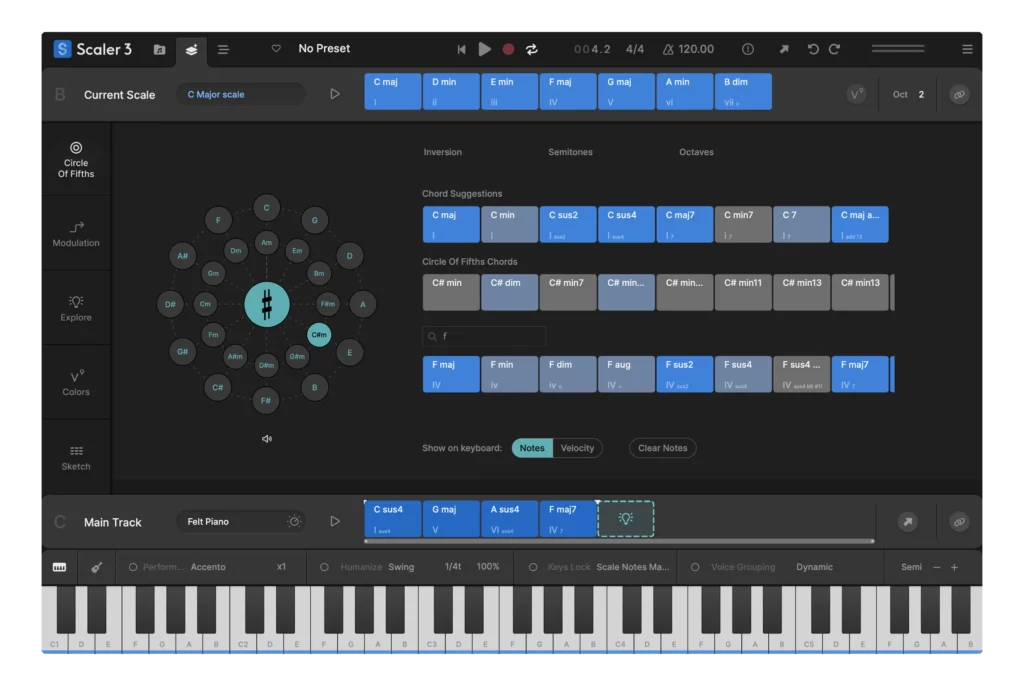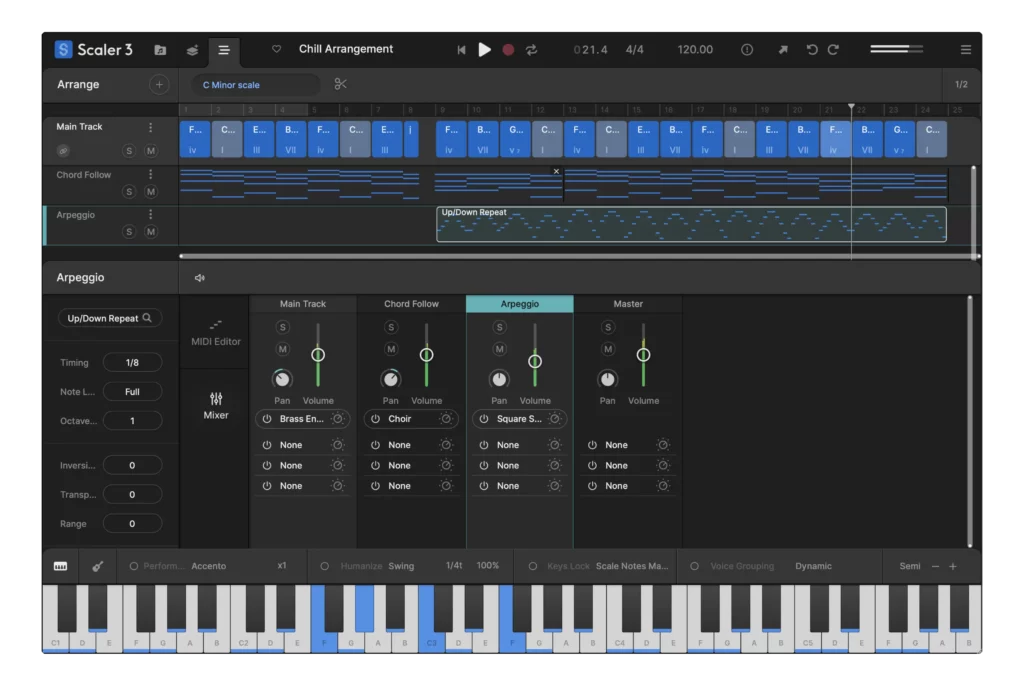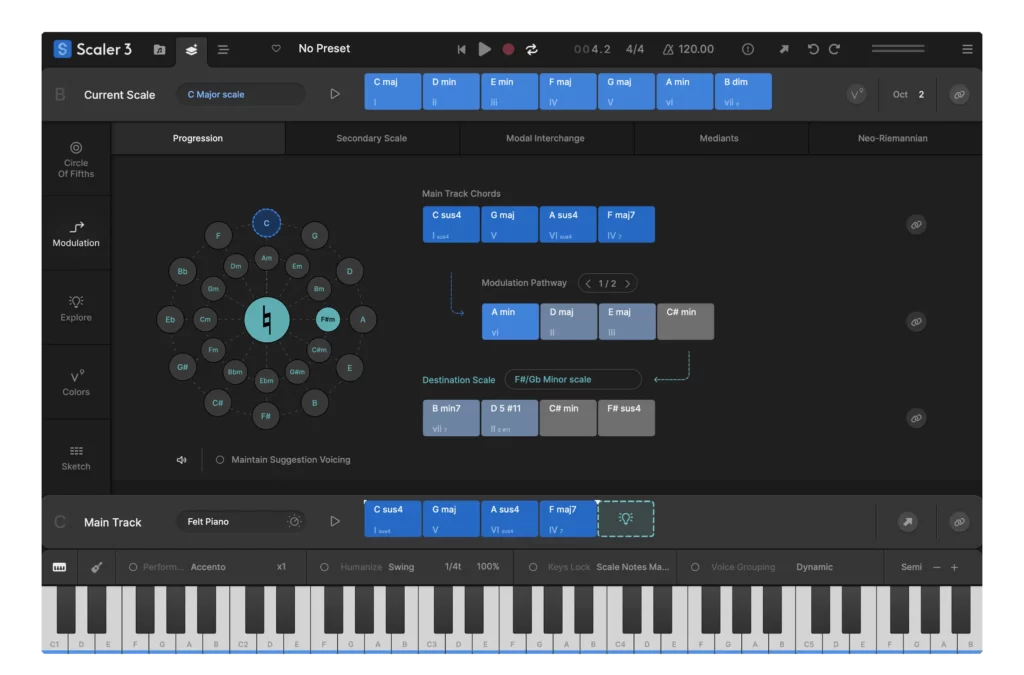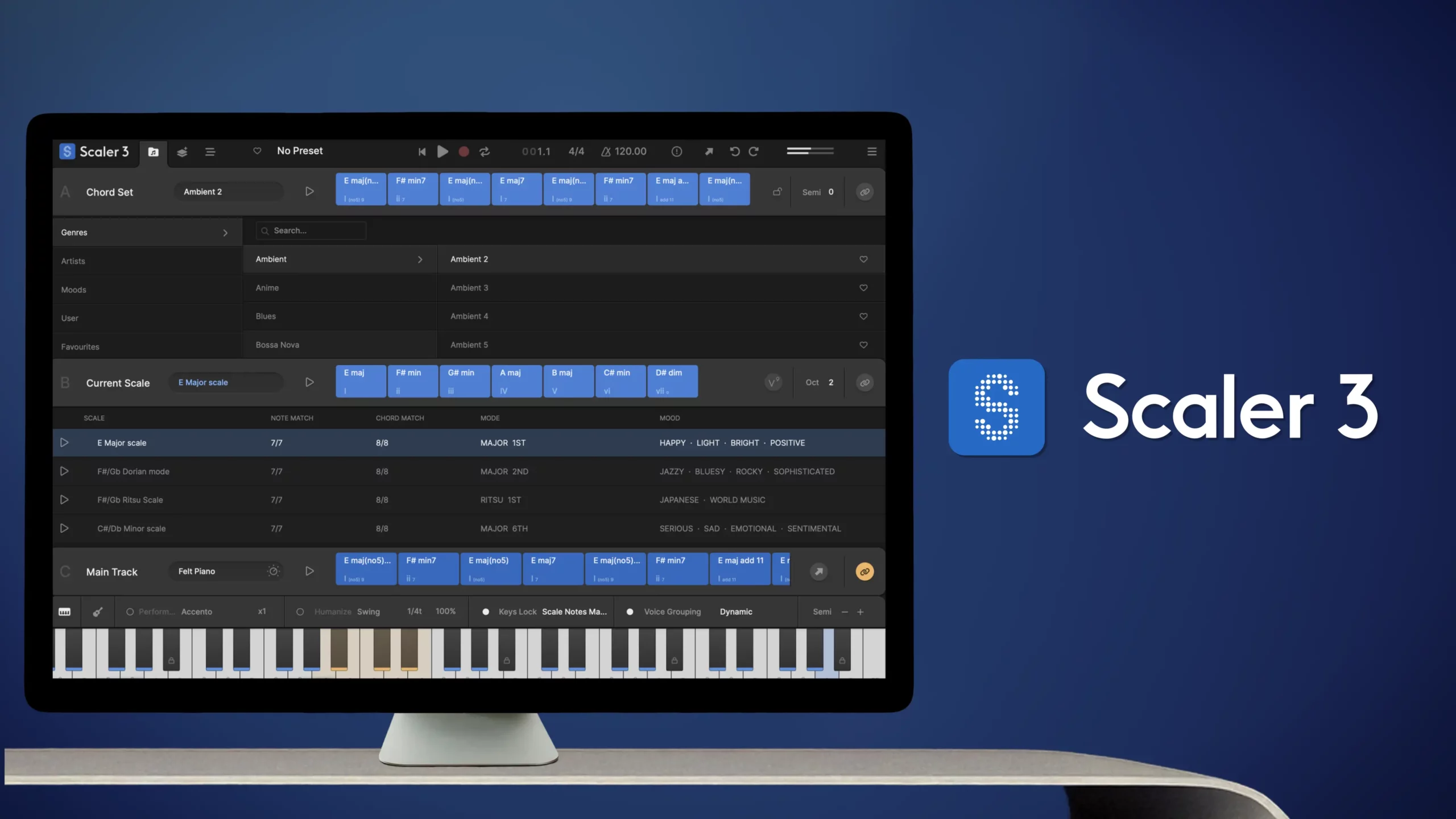Scaler 3 by Scaler Music is a next-generation music creation platform designed for musicians, producers, and composers alike. I have spent a lot of time working with digital audio software, and what struck me about Scaler 3 is its innovative approach to music theory and composition. This software offers an all-in-one suite of tools where you can explore chord progressions, find inspiring melodies, and even generate new ideas that you may not have considered otherwise. With an intuitive interface and robust features, Scaler 3 aims to lift up creators whether you are still learning the basics or are an experienced musician looking for fresh inspiration.
This article will take you through a detailed exploration of Scaler 3, laying out its key features, tools, integrations, and the impact it has on the world of digital music production. I have organized the content into high-level sections to help you get a complete picture. In other words, you will check out everything—from understanding the background and motivation behind the product to getting into its advanced functionalities. If you enjoy learning about innovative music technology, you will find this all-in-one guide both informative and inspiring.
Here are some key details about Scaler 3 at a glance:
Product Name: Scaler 3 by Scaler Music
Website URL: scalermusic.com
Price: Various licensing models available, including a free trial option and premium updates for ongoing users
Developers: Scaler Music Team
Overall Rating: Users and reviewers have given it high marks for its innovative approach and ease of use
Customer Support: Fast and responsive support through forums, online documentation, and video tutorials
The goal of this article is to provide you with an in-depth understanding of Scaler 3. Whether you want to learn how the platform can improve your workflow or you are curious about advanced music theory tools integrated into the software, I hope you find these insights helpful. Let’s jump in and uncover what makes Scaler 3 a standout tool in modern music production.
Related Post:
- I Used Scaler 3 for 10 Minutes Here’s What Happened!
- The Fastest Way to Layer Drum Sounds in Your DAW (Using DC Snares!)
- The Ultimate Guide To Creating A Concept Album
- Write Better Songs Faster – Hookpad’s Revolutionary Approach To Hooks
About the Creators and the Adventure of Scaler Music
Scaler Music is led by a group of seasoned musicians and developers who recognized the challenges faced by modern creators. The team behind Scaler 3 brings together decades of experience in music production, sound design, and programming. Their goal was clear: to build a platform that not only simplifies the creative process but also takes it up a notch by integrating advanced music theory into an accessible toolkit.

Before developing Scaler 3, the creators spent countless hours immersed in both the technical and artistic sides of music production. This dual focus allowed them to produce software that respects the time-honored traditions of music theory while harnessing the latest technological advancements. They understood early on that musicians need more than just a sequencer or a simple chord generator. What they needed was an ecosystem where intuitive design meets robust functionality.
In many ways, Scaler 3 is a testament to the hard work and dedication of its developers. The entire team is committed to continuous improvement, often taking cues from both user feedback and the ever-evolving trends in music production. Their philosophy is that every musician—whether self-taught or classically trained—should have the tools to bring their creative ideas to life. The result is a platform that feels both familiar and groundbreaking.
It isn’t just about creating software. It is about building a musical community. The Scaler Music team has embraced an open approach where users can interact with the developers through forums and regular update cycles. In this regard, Scaler 3 represents a symbiotic relationship between creators and the makers behind the software. This ensures that the product evolves in a way that serves everyone.
Core Features and Functionality of Scaler 3
At its heart, Scaler 3 is built around the concept of unlocking musical potential. One of its strongest features is the intelligent chord detection and progression generator. When a user inputs a melody or a chord, Scaler 3 can analyze the music and suggest chord progressions that fit perfectly within the scale, genre, or mood you are aiming for. This single feature can save hours of tweaking and trial-and-error, making it easier for you to focus on the creative aspects of your work.

The software offers an extensive library of chord sets, scales, and rhythmic patterns. This library is not static; it updates regularly with new presets and inspirations based on user input and industry trends. Scaler 3 is capable of handling everything from simple pop chord progressions to more complex jazz harmonies, delivering versatility that caters to diverse musical styles.
Another noteworthy function is its drag-and-drop interface, which allows you to audition and tweak chords in real-time. It even comes with a preview feature so you can hear how different progressions will sound within your arrangement. For producers working with digital audio workstations, Scaler 3 integrates seamlessly as a plugin, making it easy to bring its powerful recommendations directly into your workflow.
Here are some of the core features that many users find indispensable:
- Intelligent chord detection and progression suggestions
- An extensive, genre-spanning library of chords, scales, and rhythms
- A drag-and-drop interface for smooth integration with your DAW
- Real-time audio preview to double-check your creative choices
- Advanced customization options for fine-tuning chord suggestions
These features make Scaler 3 not just a tool, but a creative partner in your music production process.
Additionally, the software excels at simplifying music theory. Many musicians may understand the basic principles, but applying them in real-time composition can be challenging. Scaler 3 bridges this gap by automatically translating theoretical ideas into actionable chord suggestions that step up your musical projects. This approach demystifies the process, making advanced theory accessible to everyone.
Deep Check Out into Music Theory Tools and Creative Suggestions
One of the standout aspects of Scaler 3 is how it uses music theory to inspire creativity. I have often found that a fresh perspective on chord progressions or a novel scale suggestion frequently leads to breakthroughs in songwriting. Scaler 3 excels at offering these breakthroughs by analyzing your input and suggesting multiple creative pathways.

The tool offers a range of modes that cater to both beginners and experts. For instance, the ‘Explore’ mode provides guidance for those who are still learning the nuances of chord construction, while the ‘Pro’ mode is designed to challenge seasoned musicians with more intricate progressions and modulations. This dual approach means the software grows with you, always offering something new regardless of your experience level.
Another feature I appreciate is the extensive library of chord variations. Not only does the software suggest basic major and minor chords, but it also introduces extensions, alterations, and inversions that can add color and complexity to your compositions. This is particularly useful when you want to move beyond standard progressions to evoke a more sophisticated and unique sound.
In addition, Scaler 3 includes a MIDI export option that allows you to easily integrate the suggested progressions into your digital audio workstation. This means that after checking out and tweaking ideas within Scaler 3, transferring these creative insights into a full-fledged project becomes a smooth process. The software acts as both a brainstorming tool and a practical, production-ready assistant.
The thought behind Scaler 3 is to eliminate the friction often encountered during the creative process. Rather than get bogged down by technicalities, you can let the software do the heavy lifting while you focus on the emotional and artistic aspects of composition. As a result, you often end up with ideas that push the boundaries of your usual style, inspiring innovation and experimentation in your work.
Expert Classes and Tutorials: Learning with Scaler 3
Scaler 3 is not just a tool for automatic composition—it is also a learning platform designed for those eager to deepen their understanding of music. Recognizing that technology can be a daunting field for many musicians, the developers have embedded a series of expert tutorials and educational classes into the software. These resources are aimed at helping users understand both the technical and creative aspects of using the tool, ensuring that you get the full benefit of its advanced features.
The educational content provided by Scaler Music includes step-by-step video guides, in-depth articles, and interactive lessons that cover everything from the basics of chord construction to advanced modulation techniques. These tutorials are arranged in a way that makes complex concepts easy to grasp, even if you are new to music theory. I have found that watching a tutorial not only speeds up the learning process but also sparks new ideas for how to incorporate the software’s suggestions into my projects.
What is especially useful is the integrated help system. Every feature within Scaler 3 is accompanied by clear explanations and real-world examples. For instance, if you are unsure about how a particular chord inversion works, you can immediately access a tutorial that breaks it down with a side-by-side demonstration and audio samples. This makes the learning curve significantly less steep.
Moreover, Scaler Music organizes live sessions and Q&A forums where experienced users and even the developers share tips, answer questions, and discuss creative ways to use the software. These live classes add a personal touch to the learning process and foster a sense of community among users who are all eager to expand their musical knowledge.
Benefits of these expert classes include:
- Interactive and accessible learning material for every experience level
- Step-by-step guides that break down complex music theory concepts
- Real-time Q&A sessions to help you overcome creative roadblocks
- Integration of theory lessons with practical demonstrations
- An ever-growing library of resources that updates with new trends in music production
These educational tools ensure that you are not just using a piece of software, but actively learning and evolving as a musician with every session you engage in.
Advanced Integrations and Workflow Step Ups
In today’s fast-paced music production environment, an efficient workflow is essential. Scaler 3 has been designed to integrate seamlessly with a wide range of digital audio workstations (DAWs) and music production environments. This compatibility ensures that you can incorporate the tool into your existing workflow without having to switch up your entire setup.
One of the standout features in this area is the plugin integration. Whether you use Ableton Live, Logic Pro, FL Studio, or any other DAW, Scaler 3 can work as a plugin, offering real-time recommendations and chord progression suggestions directly within your project. This level of integration saves you valuable time and lets you experiment with different ideas without interrupting your creative flow.
Scaler 3 also supports MIDI mapping, which means you can control many of its functions directly from your MIDI controller. For example, you might assign knobs and buttons to tweak chord variations, adjust velocities, or cycle through different progression suggestions on the fly. This hands-on control not only speeds things up but also gives you a tactile connection to the music you are making.
Many users have hailed these integrations as a complete game changer. They praise the software for fitting so naturally into their daily routines, highlighting that it feels like a natural extension of their creative process rather than an afterthought. As a result, the transition from inspiration to a finished track is more fluid and less disruptive.
Additionally, Scaler 3 works efficiently with various virtual instruments and effects plugins. It allows you to quickly assign chords and progressions to synthesizers, pianos, guitars, and even orchestral modules. By automating many of the initial stages of composition, Scaler 3 enables you to focus on refining the details of your arrangements, thereby stepping up overall productivity.
The workflow improvements extend into project management as well. The software provides a history of your chord selections, which allows you to revisit previous ideas and build upon them. This archival feature is particularly useful when you are working on long-term projects or decide to revisit and revamp older compositions.
Market Impact and Innovation in Music Production
The impact of Scaler 3 on the digital music production market cannot be overstated. Over recent years, the demand for tools that simplify complex theory while offering creative flexibility has skyrocketed. Scaler 3 is part of a new wave of software that bridges the gap between traditional music theory and the creative potential of digital production. It has quickly garnered acclaim from both novice musicians and established producers.
By integrating advanced music theory into its core functionality, Scaler 3 is setting a new benchmark for what music production software can accomplish. Industry experts have noted that the ability to generate and manipulate chord progressions with such ease is a significant step forward. This innovation is pivotal at a time when musical creativity increasingly relies on digital solutions.
Furthermore, the software lifts up users by giving them insights that were once the domain of trained music theorists. This democratization of musical knowledge has led to a surge in experimentation and innovation. Musicians can now explore scales, chord modifications, and progressions that might otherwise have been out of reach, thereby broadening the horizons of digital composition.
Scaler 3 has also influenced the competitive landscape of music software. Its all-in-one feature set, combined with an emphasis on education and community, has prompted other developers to reconsider how they integrate music theory with accessible interfaces. The ripple effects of these innovations are visible in the way plugins and DAW integrations are now being designed with similar educational tools and workflow improvements.
From a market research perspective, it is clear that the new generation of music production tools is moving toward more intelligent integrations. Producers are no longer satisfied with simple loop packs or basic MIDI generators. They are looking for intelligent assistants that can understand the nuances of musical structure and help them create more dynamic and original works. In that light, Scaler 3 is not just a product, but a powerful statement about the future of music creation.
Community and Support: Building a Musical Network
One of the aspects I have truly appreciated about Scaler 3 is the community that has grown around it. Music is inherently a collaborative art, and the support network that comes with Scaler 3 is both robust and lively. From online forums to active user groups, there is a wealth of knowledge exchanged among creators who are all passionate about pushing their creative boundaries.
In the community hubs dedicated to Scaler 3, users swap tips, share chord progression hacks, and even collaborate on projects. This network of musicians helps nurture an environment of mutual growth and learning, where no question is too basic and every suggestion can spark new ideas. Discussions often cover specific challenges such as how to transition between keys smoothly or how to apply unconventional scales effectively. These conversations help break down some of the more complex aspects of music theory.
Furthermore, the Scaler Music team is very proactive in connecting with its users. Regular feedback sessions, live tutorials, and Q&A forums ensure that everyone gets a chance to ask for advice and receive personalized insight. This level of engagement drives improvements and encourages users to experiment with features they might otherwise overlook.
The community spirit is likewise evident in the way Scaler 3 is continuously updated. The developers listen to user feedback and release frequent updates that not only fix bugs but also introduce new creative possibilities. This transparent communication builds trust between users and developers, reinforcing the idea that Scaler 3 is part of a larger musical movement rather than just another piece of software.
Additionally, Scaler 3 offers collaboration tools that allow you to export chord progressions and share them easily with other musicians. This functionality is especially valuable for cooperative projects, as it helps bridge the gap between different production setups and skill levels. Whether you are in a band, working with someone remotely, or simply sharing ideas in an online forum, the software ensures that your creative vision is clearly communicated and enriched through collective knowledge.
Performance, Technology, and Reliability
When it comes to the technical side, performance and reliability are key. Scaler 3 is engineered with a focus on speed, efficiency, and seamless integration. Its lightweight design ensures that even on less powerful systems, the software runs smoothly without draining your system resources. I found that the real-time preview and audio rendering functions are exceptionally responsive, allowing for a fluid creative process.
The software is built on a robust framework that emphasizes minimal latency. This is crucial when you are in the middle of a creative session and need immediate feedback on changes to your chord structures or progressions. Its precise performance metrics mean that you can confidently rely on Scaler 3 during live performances or studio sessions without interruption.
Scaler 3 also incorporates a cutting-edge algorithm that analyzes musical input quickly and accurately. This advanced signal processing ensures that the chord suggestions, scale identifications, and modulation options are consistently on target. Users have reported that the integration works flawlessly with various DAWs, allowing for a hassle-free experience even when managing complex projects with multiple layers.
Another technical highlight is the software’s compatibility with different operating systems. Whether you use a Mac or a Windows PC, Scaler 3 adapts well to your environment, providing consistent and reliable performance. Regular updates and a responsive support team further ensure that any technical issues are addressed promptly, minimizing downtime and keeping your creative momentum intact.
For those who appreciate detailed technical information, Scaler 3 provides a complete log of updates and performance metrics. This transparency is a testament to the developers’ commitment to quality and instills confidence in the software’s long-term viability. With every update, Scaler 3 brings faster processing speeds, more precise chord recognition, and improved audio clarity to your productions.
Pricing, Licensing, and Membership Options
When considering a tool as powerful as Scaler 3, understanding the pricing and licensing structure is very important. Scaler Music has designed a flexible pricing model that caters to both hobbyists and professionals. Starting with a free trial, users have the opportunity to explore the full capabilities of Scaler 3 before making a commitment. This risk-free entry into advanced music production software is one of the aspects I found particularly appealing.
The free trial version of Scaler 3 is fully featured, giving users an all-in-one look at everything the software has to offer. If you decide to continue, there are several licensing options available, depending on your needs and budget. The standard license is available at a competitive price that reflects the quality and breadth of the included features. Additionally, a premium option offers extended functionality, such as expanded chord libraries, advanced integrations, and priority customer support.
Key points in the pricing structure include:
- Free Trial: Complete access to all features for a limited period with no credit card required.
- Standard License: An affordable option for serious music creators that comes with regular updates and access to the core feature set.
- Premium License: Designed for professionals who need the full suite of tools, including advanced customization and integration capabilities.
This tiered approach allows you to select a plan that best fits your creative requirements and budget. The pricing is transparent with no hidden fees, aiding you in making an informed decision.
Moreover, licenses are typically offered on a yearly basis, with discounts available for long-term subscriptions. The investment you make in Scaler 3 not only grants you access to the latest software innovations but also includes a commitment to continuous development and fresh updates, ensuring that the tool remains at the forefront of music production technology.
The flexibility in pricing combined with the high level of functionality positions Scaler 3 as a cost-effective solution for musicians dedicated to taking their craft up a notch. By investing in this tool, you are not simply purchasing software—you are joining a community that values continuous learning, innovation, and creative expression.
Wrapping Up Thoughts on Scaler 3: Innovation Meets Musical Creativity
After checking out the myriad features and step-ups that Scaler 3 by Scaler Music brings to the table, it is clear that this software is more than just another plugin. It is an all-in-one ecosystem that marries advanced music theory with intuitive design, providing an environment where both beginners and professionals can thrive. My experience with Scaler 3 has shown me that it truly pushes the boundaries of what is possible in digital music production.
By reducing the time spent on technical details, Scaler 3 lifts up users to focus more on the creative process. Its ability to break down complex theories, suggest innovative chord progressions, and integrate seamlessly with popular production tools has opened up new avenues for artistic exploration. The ongoing dialogue between users and the developers ensures that the software remains relevant and continually adapts to the evolving needs of musicians everywhere.
It’s very important to note, however, that while Scaler 3 provides powerful tools and educational resources, the ultimate success of any musical project still rests on your creativity and dedication. The software offers a structured pathway to inspiration, but it is up to you to take those suggestions and turn them into a masterpiece. The balance between technology and human ingenuity is what keeps the art of music dynamic and ever-changing.
Scaler 3 has arrived at a time when the digital music landscape is rapidly switching up, and its focus on community, innovation, and practical functionality makes it a standout option. I have witnessed firsthand how powerful the blend of technology and creativity can be when you are equipped with the right tools. Whether you are recording in a professional studio or working on a home project, Scaler 3 helps streamline your process, offering you a richer array of sounds and ideas from which to work.
In the end, Scaler 3 by Scaler Music is a testament to what can be achieved when passionate musicians and skilled developers join forces. By putting extensive research, ongoing education, and community support at the core, Scaler 3 becomes not just a piece of software but a creative partner that grows with you. For anyone curious about exploring new frontiers in music composition and production, now might be the perfect time to try out the free trial of Scaler 3. Jump into it, experiment with its features, get involved with the vibrant community, and see how this tool can transform your approach to making music.
PS. If you have any questions or need any help navigating the features of Scaler 3, the community forums and generous support resources are only a click away. I encourage you to make it easy for yourself by taking full advantage of these assets—they can be a valuable boost as you continue to hone your craft.
Additional Insights and Future Directions
Over the past few years, there has been a noticeable glow-up in digital music production tools, and Scaler 3 stands at the forefront of this next stage of innovation. Many users have remarked on how the software not only brings together a diverse set of musical functionalities, but also captures the spirit of creative collaboration. It encourages you to mix things up and experiment freely while still providing a solid theoretical foundation. The regular updates and community-driven improvements mean that what you see today is only the beginning, and the future holds even more exciting features.
Looking ahead, the development team behind Scaler 3 has shared plans to expand the platform further. They are working on incorporating more interactive tutorials, deeper integrations with industry-standard plugins, and even more streamlined workflow enhancements. These upcoming features are designed to let you tap into emerging trends and blend evolving musical ideas with traditional techniques. By staying in tune with user feedback, the developers are ensuring that every update will bring new dimensions to your creative process.
Furthermore, the educational resources are expected to broaden significantly with more live sessions, hands-on workshops, and even collaborative projects that allow users to work together in real time. The goal is not only to provide a tool but also to nurture a robust learning community where musicians of all skill levels can share insights and learn from one another. This collaborative spirit is a key driver behind the platform’s success, as it transforms a single piece of software into a living, breathing hub of creativity.
From a technical standpoint, there are plans to further reduce latency, improve audio clarity, and fine-tune the intelligent algorithms that power the chord recognition and progression suggestions. The developers are also exploring ways to integrate artificial intelligence more deeply into the software, so that it can better predict and suggest musical ideas based on your personal creative style. As these enhancements roll out, users can expect an even more responsive and intuitive experience, making the creative process even smoother.
This forward-thinking approach not only reinforces Scaler 3’s position as a game changer but also sets a high benchmark for future developments in the music production space. By continually updating both its feature set and its educational resources, Scaler 3 is preparing to meet the challenges of tomorrow’s musical landscape. It is evident that the passion behind the software is matched only by its potential to reshape how music is composed, produced, and shared.
Wrapping up, the journey with Scaler 3 is far from over. As the platform continues to evolve, it promises to bring even more powerful tools and opportunities to musicians around the world. Whether you are looking to jump into new creative projects or simply want to experiment with advanced music theory in a user-friendly package, Scaler 3 is poised to remain a vital companion on your musical adventure.
>>>>> Check Out Scaler 3 Here <<<<<<
These are my affiliate links for Plugin Boutique. If you purchase through these links, I may earn a commission at no additional cost to you.I appreciate any assistance you can offer. Also, I’m only endorsing products and services I use or think will benefit my subscribers.
Related Posts:
- Plugin Boutique Coupon Codes & Big Discounts
- Unlock the Power of Vocal Editing with Synthesizer V: Vocal to MIDI & MIDI to Vocal
Over 4 Million Sounds
Turn samples into songs with a versatile plugin suite. Loopcloud DRUM and Loopcloud PLAY craft pro‑quality beats and melodies that sound like you, and no one else.





Leave a Reply